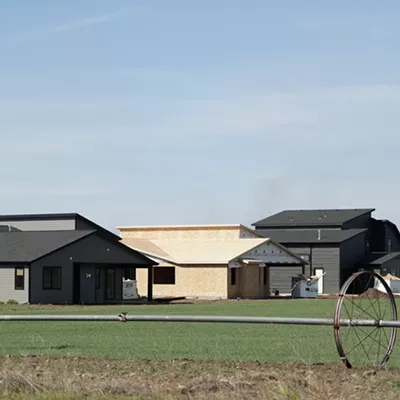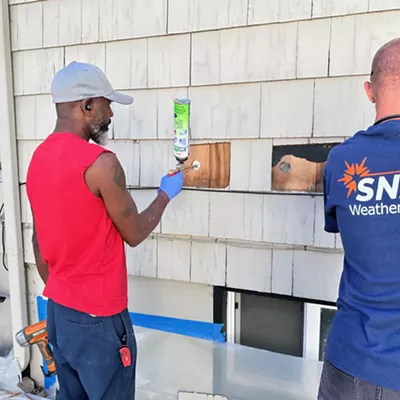By the end of March, the Spokane Police Department had busted 43 methamphetamine labs -- almost twice as many as at this time last year -- and there is no sign that the numbers are going to slow down.
Meth is Spokane's drug of choice, and what separates it from other illegal drugs is the fact that people can make it themselves.
The effects of meth are basically the same as those of crack cocaine, except that it will keep you high for as many as 12 hours, as opposed to four on crack. And it's very addictive.
"With crack, about 83 percent of users become addicted, but with meth, I've heard anything from 92-95 percent," says Spokane Police Department Lt. Darrell Toombs, commander of the department's joint drug team and supervisor of the Special Investigative Unit. "It's about the same price, and I think the reason it's so popular right now is that people get more bang for their buck." Between 75 and 80 percent of the cases his unit takes on right now are meth related.
It took some time before the meth epidemic hit Washington state and Spokane full force, but last year Washington was second only to California when it comes to counting meth labs.
In 2000, a total of 1,430 labs were busted across the state (74 in Spokane County alone). The SPD expects to bust at least 150 this year -- but that will not be all of them.
"If I had the manpower, I could do one or two [labs] a day," says Toombs. "Right now, we are totally reactive. I don't have the manpower to go out and seek these things out. The labs we deal with are the ones our patrol officers stumble upon or when someone walks into the office saying, 'Hey look, our daughter is manufacturing meth.' "
Toombs deals with as many cases as possible with the staff he has, and even though he's gotten extra funding for equipment he has not gotten a special budget to deal with the meth busts.
"There would be no point in the [police] chief giving me any more manpower or any more money, because the prosecutors, the health department, the court system, everyone is totally bogged down with meth cases," says Toombs. "I mean, the rest of the system can't handle what we are already giving them."
He estimates that about 40 percent of the meth used in Spokane is made in the area. The rest still comes up from Mexico, through the Tri-Cities.
"Most of our labs are relatively small. They make just enough for themselves and then a bit more to sell, so they can make enough to buy chemicals for the next batch," says Toombs. The average meth user used to be a white male about 30 years old, but that profile is changing, as the drug spreads to women, older and younger users as well.
The epidemic
Homemade methamphetamine has grown steadily in popularity over the past decade. And as demand for the dangerous and extremely addictive illegal drug has grown, its manufacturing process has evolved from cumbersome and very dangerous, to one that's fast and simple -- yet still dangerous.
In the early days, cooking meth involved lots of equipment and complicated chemical reactions that -- if carefully tended -- simmered, distilled, evaporated and crystallized over several days. The stench that process emitted is described as a mixture between male cat urine and cheap toilet cleaner, and the entire contraption had an unpredictable tendency to blow up. It also polluted surroundings with chemical compounds. Many times, when these labs where discovered, the homes they were in were deemed permanently unfit for human residence.
This method was especially popular among biker gangs, so today it's often referred to as the Biker Method (or the P2P method).
The one ingredient a cook needs to manufacture meth is something with ephedrine or pseudo-ephedrine in it. The P2P method reduces ephedrine to meth.
"It was in 1989-90 that we first saw meth labs become a profile of concern," says Mike LaScuola, chemical specialist with the Spokane Regional Health Department. "When we found them, the homes where so contaminated with chemicals that they were destroyed. It was bad. But then the federal authorities put limits on how much P2P you could buy at a time, and we haven't seen one of these labs since '95."
After that restriction took effect, meth cooks got creative.
"Then, due to Yankee ingenuity or what have you, someone found a way of getting ephedrine from over-the-counter drugs," says LaScuola, "and the second generation lab was born."
The second-generation method is also called the red phosphorous method, and it lets experienced cooks using simple equipment produce ready-to-smoke meth in about three hours. These labs still have a tendency to blow up, and the fumes and chemicals used in the production are extremely hazardous.
But an even quicker method, one that actually was used by Hitler's troops in World War II, uses lithium from a battery as a catalyst. This method requires very little equipment, so little that the makings for a lab can be contained in a backpack.
"This method is very popular, in terms of desirability of the dope," says LaScuola. "The dope is probably 90 percent pure, and it takes less than 45 minutes to make a batch -- that's a pretty scary perspective." Only a very few labs using this method have yet been found in Spokane, but it's the predominant type of lab found on the West Coast.
Though many stores have limited the amount of cold medication a person can buy at any one time, the chemicals and equipment needed to make meth are easy to get a hold of. On their own, they are not narcotics, but mixed in the right way they can produce meth.
"Any dummy can get this together and cook meth at their house," says LaScuola. "They invest maybe $250 and make one ounce, which has a street value of $2,000. This is not like heroin that has to be imported. And, yes, it is an epidemic."
The drug
"Meth causes a profound release of neurotransmitters in your brain and that affects your sense of pleasure, sex, hunger, pain, everything," says LaScuola. "Over time, the drug may damage the neuroreceptors in the brain or it depletes you of neurotransmitters. Quickly, it'll take more and more meth to get high."
According to the Health Department, as meth tolerance builds, an established user may require as much as 300 milligrams injected every few hours around the clock -- for three to six consecutive days to get high.
"When users first get high, sometimes they can turn the high into some purposeful, intelligent activity, like cleaning the house," says LaScuola. "Then people get into less purposeful activities. Users take things apart and they can't put them back together again. Or women may be putting on makeup and fixing their hair over and over again for hours and hours." Users will pick at sores endlessly and often have sores on arms and hands.
During a run of meth use, users typically don't eat or drink much, which leaves them coming down not only craving a new high, but also dehydrated and nutritionally depleted. Permanent users lose a lot of weight, their hair starts falling out and their teeth go bad. And after the best high ever comes the worst low imaginable.
"Trying to come down off meth, it's like the worst hangover you can imagine," says LaScuola. "It may take as much as six months for your body to repair the damage you did to it the first time you got high. If you decide to get high for a weekend, you should be ready for a week of aches, weakness and scary depression to follow."
The social consequences of using are equally bad.
"Users get all absorbed in the habit, and if they have kids, neglect is often an issue. I mean, we found a family where the children had been left with a bag of Cheetos and a six-pack of
7Up -- that was their food for the next couple of days," says LaScuola. "You just feel awful for these people. They have nothing, their lives are not going anywhere. This is a very bad issue."
The bust
As the use of meth has spread, so have the labs. They are found in cars, in backpacks and in homes. It's estimated that one successful meth cook teaches the trade to 10 new cooks every year.
"We find labs in nice homes and in junk homes. The ones that are permanent, and where the cooks are using themselves, are pretty easy to spot," says Toombs. "They let their hygiene go, then they quit taking care of the house and the yard and it quickly looks like a junkyard around their house." But with the increasing popularity of mobile labs, some cooks set up temporary shop at motels or friends' houses, cook a batch or two and then leave.
Regardless of where the lab is located, a bust involves a lot of people other than the SPD.
"It's not only the police that's there," says Toombs. "We have paramedics there, in case someone gets hurt during the entry, and we have the fire department there, with a hose truck, in case the place catches fire or something of that nature. Once we are in, we release the paramedics, but we keep the fire truck there."
Any prisoners after a meth lab bust have to be decontaminated before they can be sent to jail.
"That means the hazardous materials unit has to send out a couple of trucks to set up the showers inside the big tents," says Toombs. "They have to catch all the water they use, in case there are chemicals in it. When they are done, the fire department tests the water, and so far we've been lucky, the chemicals have not been that bad and they can just dump the water down the drain."
Then every chemical container, every single piece of what may be evidence in a drug trial, is collected and entered into a computer.
"We usually have between 50 and 100 pieces of evidence from each bust," says Toombs. "Then [the state Department of] Ecology comes out and disposes of all the chemicals. And toward the end of the process, the health department comes out and posts the house."
The aftermath
If a house has been used as a meth lab for a longer period of time, chances are that it's contaminated with hazardous chemicals. Meth cooks typically don't label containers, and some hazardous chemicals are stored in containers that were made for something else.
The list of chemicals reads like a chemical plant inventory: anhydrous ammonia gas, which even in low concentrations is very irritating to skin, eyes and respiratory passages; it may cause first- and second-degree burns to skin, or lead to fluid in the lungs. Sodium hydroxide (lye) is a strong alkaline compound, which irritates eyes, skin and mucus membranes. It may cause very deep burn wounds, and mists or vapors can lead to severe eye damage. When heated, lye emits toxic fumes. Methyl alcohol (wood alcohol) is intended for use as a paint thinner and is only mildly toxic upon inhalation, but it's poisonous when ingested. It's also highly flammable, and when heated it emits toxic fumes. And these are just a few of the chemicals used to make meth.
"The cooks put themselves at very high risk while handling these chemicals," says Mark Stephens, with the Department of Ecology. "Sometimes, through [meth-induced] paranoia, they close up the windows and doors, at the same time as they are heating up these very reactive and flammable chemicals. The risk for something to go wrong is incredibly high." Chemical residue sticks to the clothes of people living at the lab, and may contaminate kids playing on the floor or pets wandering around the residence.
"Environmentally, we are really concerned about how they dispose of the chemicals. This is really nasty stuff that may end up being just dumped down the nearest drain," says Stephens. Ecology is the first one in after the police are done collecting evidence.
"Our work begins when the police are done processing for evidence, which typically means they have removed all the glassware and hot plates and things like that," says Stephens. "Our job is to evaluate and handle the waste. We provide a preliminary hazardous classification, and then take it to the transfer station. From that point, we do bulk shipment through the state; every six weeks we have a shipment that goes out."
Last year, Ecology spent $500,000 cleaning up after meth labs statewide -- this year the department expects to spend $1 million. It has already cleaned up waste after 57 labs in Spokane County this year.
After the environmental toll has been calculated, the human toll still remains. The stationary labs are often located in rental homes, and once the bust is over, residents are not allowed to move back in until the site has been decontaminated.
"We have 14 days to do the actual assessment of the place. At any time, we can say that the place is unfit for human use, but that basically leaves the residents out in the street," says LaScuola. "With the second generation labs that we see most often, there is not as high a risk for contamination as with the older ones, but there's still a risk." LaScuola often finds himself between a rock and a hard place trying to sort things out between the renter and the landlord.
"I have a difficult task. The property owner may have to pay $10,000 for cleanup, to wash the walls and clean out the ventilation system, throw out carpets and all the appliances," he says. "And people want back into the house -- all their stuff is there. And sometimes the circumstances, I mean, we find filthy homes with gross contamination of all sorts -- these are people who have gone down the drain. But we have to do a case-to-case evaluation, and it's killing us."
LaScuola is the only person at the Regional Health District to handle these cases, but he says Spokane is fortunate to have good cooperation between police, health department and Ecology.
Still the cost associated with each bust is high. For Ecology, the average response cost $600, but some run as much as $3,000. In one bust, some of the chemicals found were suspected of being radioactive, and it took weeks to locate a company that could deal with them.
For the police department, each bust runs about $1,500 -- not including any investigative work leading up to or following the bust.
"I'd say the total cost for every initial incident response is between $4,000 and $5,000 when you include us, the fire department and the paramedics as well," says LaScuola. "And then I'm not even talking about the costs that follow, say, if children have to be taken into custody by Child Protective Services or the cost of rehab for users."
The solution
The SPD maintains that meth use, and the crimes committed to support meth addiction, continues to be the biggest single factor in Spokane's crime picture.
According to SPD numbers, violent crimes were down in Spokane last year, but property crimes were up. Most dramatically, vehicle thefts were up 34 percent from 1999, and car break-ins were up 30 percent.
"Somehow we as a community need to get a handle on the demand side of the drugs, rather than just catching the small users a dozen at a time," said Police Chief Roger Bragdon, earlier this year. "The numbers -- police versus users -- are against us. Our community needs more input from all the agencies that have responsibility in dealing with drugs and users."
Both LaScuola and Toombs agree that the way authorities in Spokane are attacking the meth problem by working together is correct, but they are hard pressed for ideas as to how to curb the problem. Getting more information out to potential users about what using meth will do may slow the demand, but there are also ways to attack the supply, and that is the approach currently favored by law enforcement and social service agencies.
"They need ephedrine to make meth, so putting a limit on over-the-counter cold medications and diet pills should help," says LaScuola.
Toombs supports that idea, but tells of one incident where a small store was selling large quantities of cold medication out of the back door, for extra cash.
Still, the meth cook's Achilles' heel is the access to ephedrine, but drug companies may be reluctant to voluntarily limit their presence on the lucrative cold medication market.
"Ten years ago, they put a limit or made it impossible to buy certain types of the precursor chemicals, like certain types of acids and things like that, without a license," says Stephens. "It took a little while, but then the meth cooks figured out how to make their own precursor chemicals. So the limiting of purchasing ephedrine and pseudoephedrine probably stands a better chance of curbing this, than some of the other restrictions, because you have to start with that. You can't make meth without ephedrine."
Besides grocery stores voluntarily putting cold medication and diet pills behind the counter, legislation limiting over-the-counter sales has been proposed through the Board of Pharmacists.
"The problem is those would be state regulations, and we are too close to Idaho or Canada. It would be too easy to go and buy it somewhere else," says Stephens. "In Yakima, they still come across huge lots of ephedrine that clearly did not come from stores in the area. Overall, with the small labs, just locally, stores could have an impact by making it much tougher to buy ephedrine. We have to start somewhere."
















